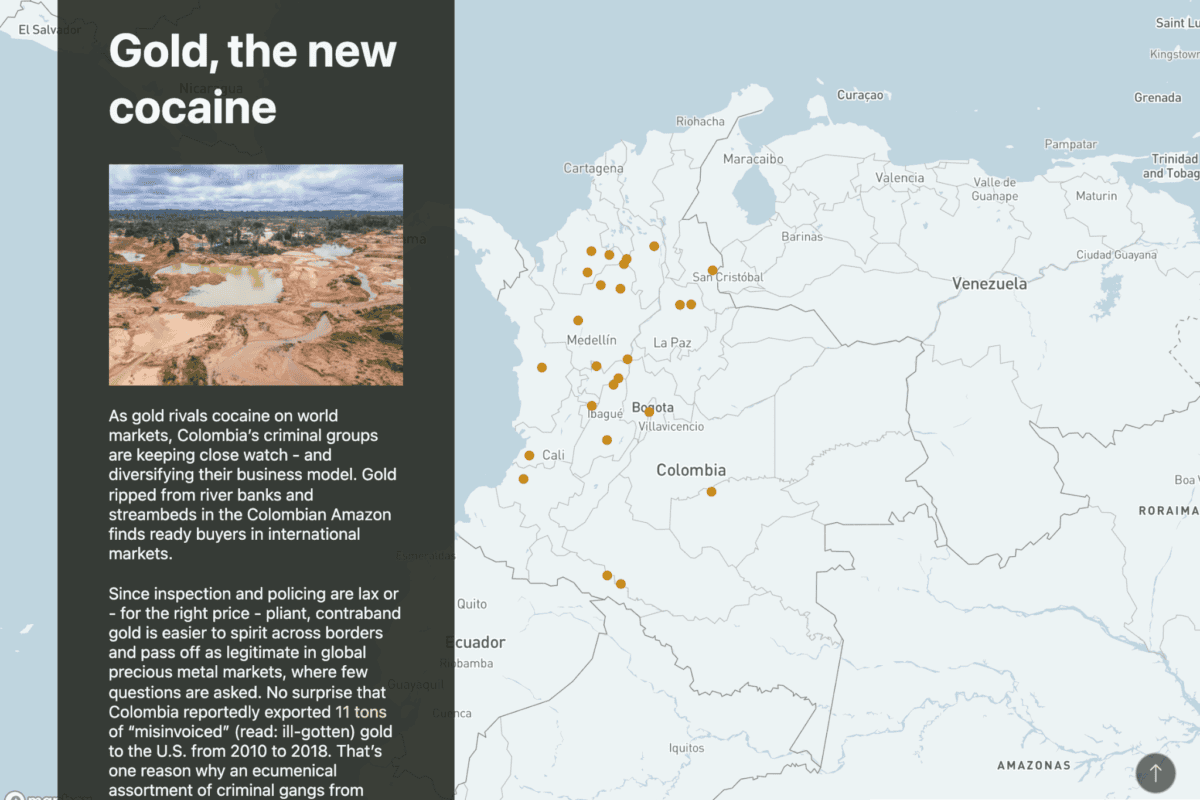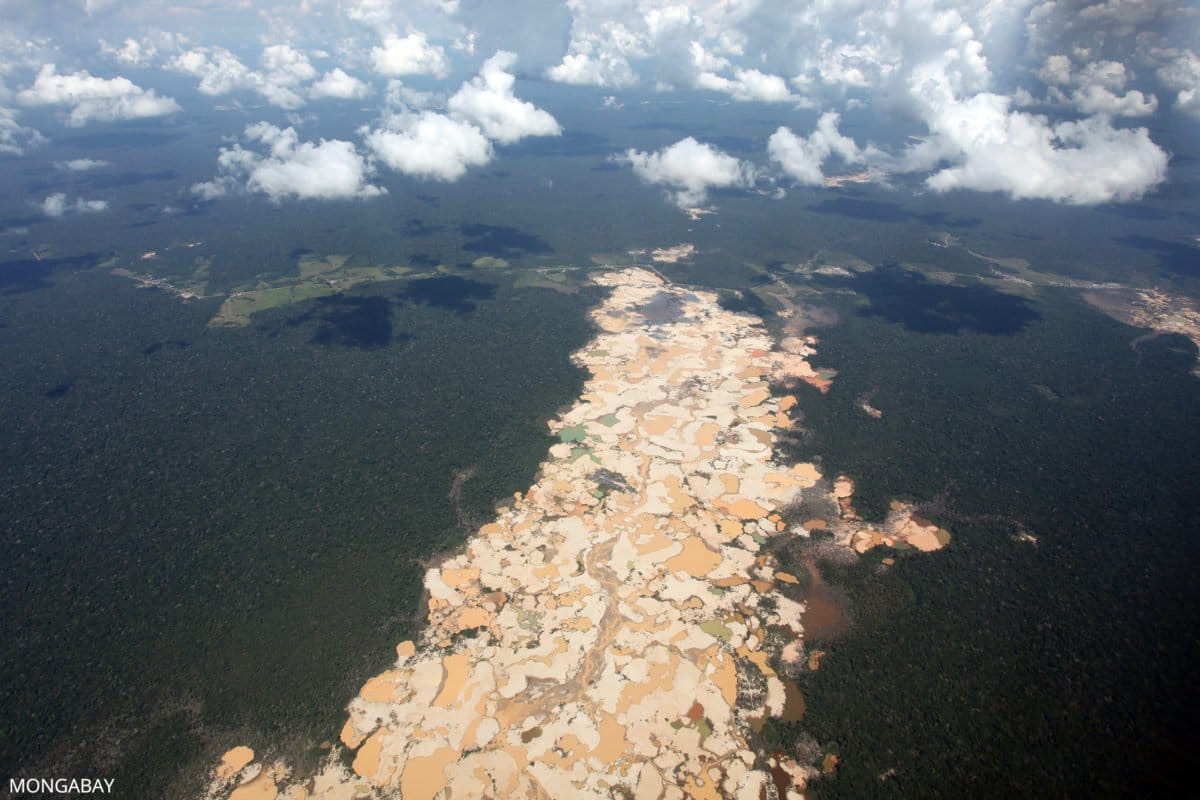
- Once the epicenter of the global trade in gold, illegal mining is once again surging across the Amazon.
- Its extraction and trade is not only fueling corruption, money laundering and criminal violence – it is accelerating deforestation in the world’s largest tropical forest, says Robert Muggah, co-founder of the Igarapé Institute.
- Muggah details a range of challenges facing efforts to rein in the gold mining sector. He says political leadership is critical to make progress on the issue: “Absent political will from the top, however, Brazil’s gold chain will continue to resemble the wild west.”
Once the epicenter of the global trade in gold, illegal mining is once again surging across the Amazon. Its extraction and trade is not only fueling corruption, money laundering and criminal violence – it is accelerating deforestation in the world’s largest tropical forest.
The latest spike in wildcat mining is driven by international demand. The price of gold is up from $400 in 2000 to over $1,800 an ounce in 2022. And ground zero for the clandestine gold rush is Brazil where researchers have documented tens of thousands of small-scale miners and more than 320 illegal mines, though the real number is likely higher. Legally and illegally mined areas have expanded sixfold across Brazil between 1985 and 2020 – from 31,000 to 206,000 hectares. Today, Brazil is among the world’s top ten exporters of gold. One of the problems, however, is that a significant proportion of it is illegal.

In Brazil and across the Amazon illegal gold mining is expanding on Indigenous territories and protected areas. Between 2010 and 2020, mined areas (what is referred to colloquially as garimpo, or wildcat mining) within Indigenous zones increased by almost 500% while mining in conservation unit areas increased by over 300%. The most heavily mined areas in Brazil are Indigenous reserves such as Kayapó and Munduruku in Pará and Yanomami in Roraima. As for conservation units, eight of the top ten protected areas with the most illegal mining were located in Pará. And it’s not just land, but also rivers that are being heavily affected by mining. Last November, at least 300 river dredgers appeared on the Madeira river, generating headlines. Local state authorities refused to intervene since the river is considered federal jurisdiction. The National Mining Agency said it was concerned only with legal mining. The navy and federal police were nowhere to be seen.
There are a few well-known hotspots for illegal mining across Brazil. As many as nine states are involved, many of them located in the Amazon Basin. Among the most notorious areas for illegal mining over the past decade include Indigenous reserves such as Yanomani and Munduruku. The Tapajos basin – home to the Munduruku – generated up to 30 tons of illegal gold in 2018, about a third of the country’s total declared production that year, but numbers are suspect because of the way the gold supply chain operates. Some interior cities are emerging as well known illegal gold mining hubs, including Itaituba and Jacareacanga (in Pará). Levels of violent crime and victimization in and around these areas are climbing upward.

Law enforcement, environmental authorities, activists and researchers can estimate the scale and impacts of mining sites and equipment by using satellite maps. Miners dredge rivers and also move inland into forested areas with large-scale excavation gear, leaving denuded landscapes, craters and stagnant mercury-infused lakes. The legacy of illegal mining is rising deforestation in the Amazon, especially on Indigenous reserves (accounting for about a fifth of all reported forest clearance there). This extent of deforestation is being accelerated by a succession of bills and deregulation proposed by the Bolsonaro Administration that is opening erstwhile protected areas to mining, oil and gas extraction and agriculture.
In Brazil, some sites ‘attributed’ with gold mining actually do not actually produce gold at all. An example of this is Roraima where roughly $10 million worth of gold was exported in 2019 to India despite the fact that there are no officially authorized mines. There are also growing concerns in South America about the transboundary dynamics of the gold trade. Gold illegally mined in Colombia, French Guyana and Venezuela is often sold and refined in Brazilian cities in Amazonas, Amapa and Roraima. Moreover, there are multiple instances of ex-FARC dissidents (known to be involved in illegal gold mining in the Colombian Amazon) getting involved in gold extraction in Brazil proper.
The most common form of illegal gold extraction is called “hard rock mining”. This involves metal detecting, panning, cradling, sluicing and dredging. Substantial infrastructure is required to keep it running – from airstrips, airplanes, helicopters and excavators to satellite communications, generators, food supply chains, restaurants, crypto-currencies and shell companies for laundering money. Hardrock mining generates significant raw material from which gold ore is extracted. It also requires the use of sizable quantities of mercury, which helps distill the gold, but has massive and long-term environmental consequences. The business itself is opaque and poorly regulated, from the point of issuing permits and licences to the extraction and processing of gold, and selling the product onward to wholesalers and retailers.

At the center of the gold supply chain in Brazil are the so-called Distribuidora de Títulos e Valores Mobiliários (DTVMs). Authorized by the Central Bank, DTVMs are the first official trading point for extracted gold. As such, they are where “rough gold” typically enters the legal market either as a commodity or a financial asset. The DTVM is also the primary point where taxes on small-scale gold mining is collected. Once rough gold moves up the supply chain, it is exceedingly difficult to trace its origins and distinguish between legal and illegal gold.
A surge in investigations by Brazil’s federal police and public prosecutors over the past three years is shining a light on the disproportionate impact of DTVMs across the gold mining sector. Given their instrumental role in facilitating environmental crime and money laundering, DTVMs must be subjected to greater scrutiny and accountability. There is still too much willful blindness in the gold industry. For one, DTVMs are not undertaking adequate due diligence or oversight of documents provided by gold sellers who are expected to provide the exact name and geographic coordinates of mining sites. Given their critical role in enabling illegal gold mining, the regulation of DTVMs and widespread efforts to falsify names and locations of mining sites (permissao de lavar garimperias, PLGs) is essential to get the problem under control.
To be sure, the mining of gold has always experienced weak regulation and corruption. Brazil’s colonial and modern history is deeply interconnected to the production and export of gold. Portuguese colonizers triggered the world’s first global gold rush in 1690 and several of the country’s historic cities – Ouro Preto (black gold) and Vila Rica (rich town) – are a tribute to this legacy. More than 400,000 Portuguese and over 800,000 African slaves were sent to Brazil to mine gold and something in the order of 800 tons of it was mined in the eighteenth century. But Brazil’s production leveled off and it was overtaken by other countries in the intervening period.

Brazil stepped-up gold production in the 1980s to deal with debt and related financial crises. The government adjusted mining codes, the designation of reserves, and even the definition of artisanal mining and miners. Bolsonaro accelerated this process after assuming the presidency in 2019, including loosening mining constraints and incentivizing exploration. The mechanisms for buying and selling gold are largely antiquated and analogue – including the issuing of mining permits, reporting on mining reserves, and invoicing for gold. There are opportunities to digitalize these processes, but companies have been sluggish to take action.
Today, the National Mineral Agency is highly responsive to lobbying from the gold industry (both large and small-scale operators) and had resisted reforms to make the sector more accountable and transparent. The Central Bank could also be of help (when it comes to enhancing compliance mechanisms) but thus far has failed to be proactive. An added challenge is that both the wider market and Brazilian society at large have historically downplayed the socio-environmental impacts of small-scale mining operations. Indeed, there is even a veneration, in some quarters, of small-scale artisanal miners who are regarded as pioneers.
As in past centuries, the gold industry maintains close ties with the government. Case in point is Dirceu Sobrinho, president of the National Gold Association (Anoro), who as the owner of F D’Gold DTVM, has open access to the Palacio do Planalto. F D’Gold recently came under investigation for dumping illegal gold in foreign markets between 2019 and 2020. The company was charged with fraudulently purchasing an estimated 1,370 kilos of gold that supposedly originated from 37 sites in Para (according to PLGs). The federal police and researchers from UFMG found that none of the alleged mining sites registered any signs of exploration.

The case of F D’Gold is symptomatic of a porous regulatory system rife with corruption that is routinely exploited by private and public officials alike. Sobrinho, as a representative of Anoro, was a frequent presence in Brasilia. He routinely met with senior officials, including the Minister of Mines and Energy, Ministry of Environment, and others associated with the National Mining Agency (the Agência Nacional de Mineração or ANM). There has been a persistent tolerance of illegal practices across the gold mining sector. This is not only corrosive for governance, it has long-term environmental consequences. The damages generated by F D’Gold on the Amazon amounts to over 9,000 hectares of deforestation and mercury dumping is alleged to generate damages of upward R$ 1.7 billion.
Their close proximity with the government provides mining companies and their lobbyists with an added layer of protection. For example, the Federal Prosecution Office (Ministério Público Federal or MPF) has called for the suspension of F D’Gold. But Sobriho has reportedly leveraged connections with the Attorney General’s Office, the ANM, the Minister of Mines and Energy, and others to push back against MPF actions. Indeed, Sobrinho has taken the offensive, calling on the government to shield mining companies from unfair regulations. Urged on by Sobrinho, the ANM and Anoro are actively working to simplify mining authorizations, reduce licensing requirements, and expand mining concessions in Para, including in national forests, conservation units and Indigenous reserves.
Given the record of certain individuals involved in the mining sector and their persistent efforts to deregulate gold extraction, the latest calls by Anoro to increase accountability over the gold supply chain ring hollow. Anoro claims that it wants a tracking platform to digitize production, acquisition and sale of gold as well as a system of electronic invoices integrated with Brazil’s federal revenue service to facilitate traceability. The fact that gold mining companies have yet to take steps in this regard is telling. There are simple measures that companies could take, including setting-up alerts to monitor illegal operations, certifying gold on the ANM website, deploying tools to conduct due diligence, monitoring the use of heavy machinery, and actively tracing suspicious activities. The government, for its part, could prohibit mining in Indigenous and protected areas, require mining permits to report volumes of gold that can be viably extracted from any plot and digitalize and cross-check environmental licenses and mining permits, including with the Central Bank and Securities and Exchange Commission. Absent political will from the top, however, Brazil’s gold chain will continue to resemble the wild west.
Laura Waisbich and Melina Risso provided input on this piece.
Brazil’s illegal gold rush is fueling corruption, violent crime and deforestation
Source: Trends News

0 Comments